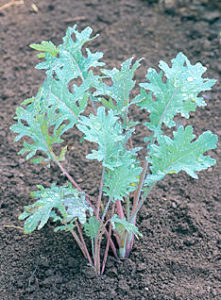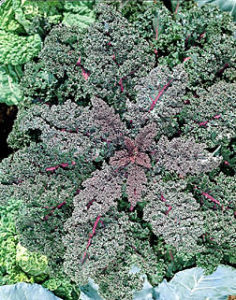 |
| Johnny’s ‘Red Russia’ kale. Photo courtesy of National Garden Bureau. |
by Jean Ann Pollard
In Maine, kale comes into its own in autumn. Healthy and tall even in November, it barely shivers when ice and snow decorate leaves and stems. In fact, cold weather seems to improve its flavor without deleting nutrition. According to The National Garden Bureau (NGB), whether raw or cooked, kale is a low-calorie, highly nutritious leafy green. It can be steamed and served with oil or vinegar, added to soups or used as a green vegetable. “Unfortunately,” says the NGB, “kale often appears in salad bars as decoration rather than on its own.”
William Woys Weaver, in Heirloom Vegetable Gardening, suggests that the genetic origin of the oleracea species of the genus Brassica can be traced “to northwestern Europe, specifically to the coastal region extending from western France to Holland and including the southern coast of England.” As often happens when tracing vegetable travels, however, others disagree. The NGB reports that “kales, with their loose leaves, are the most primitive members of the cabbage family,” having originated “in the eastern Mediterranean area and Asia Minor” where, since about 2000 B.C., they were food crops. In 350 B.C. in Greece, Theophrastus “described a savoyed form.” Furthermore, continues the NGB, kale in Europe was the most common green vegetable until the end of the Middle Ages, while it was first mentioned in America in 1669, although “it was probably introduced earlier.”
Names applied to the Brassicas come from the ancient Celts – which isn’t surprising since they may have been the first to actually cultivate these vegetables instead of merely gathering. Kale in English, for example, results from the Celtic kal; kol became Kohl in German; bresic turned into Latin brassica; and kap, a term for heading cabbages, mutated to German Kappes and English cabbage.
Selection ultimately produced many varieties: Brussels sprouts for specialized buds; cauliflower and broccoli for flowering shoots; kohlrabi for enlarged stems; kale and heading cabbages for leaves. Kale leaves are works of art. Sometimes crinkled, serrated or deeply cut and feathery, they can be blue-green, purple, white, yellow or combinations thereof. Today, its complete Latin moniker is Brassica oleracea, Acephala group.
New England accepted Europe’s cole crops early (although broccoli didn’t arrive until the 1920s with Italian immigrants); and Benjamin Watson in Taylor’s Guide to Heirloom Vegetables lists a number of heirloom varieties, referring mostly to Fearing Burr’s 1863 The Field and Garden Vegetables of America, as well as the English translation of Vilmorin-Andrieux’s The Vegetable Garden, which appeared in 1885.
 |
| Park’s ‘Redbor’ kale. Photo courtesy of National Garden Bureau. |
Watson says that ‘Dwarf Blue Curled Scotch’ is identical to the ‘Dwarf Green Curled Scotch’ mentioned by Burr. “The leaves are blue-green and finely curled and do not yellow even in severe cold.” It survives well in Maine, tastes sweeter after a frost, and if properly mulched can be harvested into December. Eliot Coleman adds that the ‘Vates’ type is a very hardy, low-growing variety ideal for a coldframe, since new leaves grow close to the ground and can be picked before they touch the glass. The Burpee company offers ‘Dwarf Blue Curled Vates.’
‘Lacinato’ is a unique, highly ornamental Italian heirloom, “and is probably the same variety that Vilmorin-Andrieux described as ‘Cavalo Nero’ or ‘Tuscan Black Palm.’ Its dark blue-green leaves look almost black at a distance, curl back at the edges, and their surfaces are heavily “blistered.” The flavor, says Watson, “is sweet and mild, particularly after frosts.” Johnny’s Selected Seeds offers ‘Toscano’ lacinato kale, noting that it tolerates both hot and cold weather. Fedco and Pinetree Seeds offer ‘Nero di Tuscana.’
The English variety ‘Pentland Brig’ (offered by the Organic Gardening Catalogue) results from a cross between smooth- and curled-leaf types. Where plants overwinter, “broccoli-like sprouts can also be harvested for eating.”
‘Red Russian,’ also called ‘Ragged Jack,’ introduced to Canada by Russian traders in the 19th century, has flat, smooth, gray-green leaves with wavy margins that resemble oak leaves. Its leaf stems and veins are reddish purple. “In cold weather,” says Watson, even “the leaves turn entirely reddish purple.” Burr described the variety as ‘Buda Kale,’ and Vilmorin-Andrieux briefly mentioned ‘Ragged Jack.’ Fedco Seeds quips that workers at Darthia farm in Gouldsboro, Maine, call the variety ‘Communist Kale.’ Johnny’s Selected Seeds notes that the ‘Red Russian’ strain is especially good for a salad mix and bunching. Pinetree also offers ‘Red Russian.’
Other varieties offered by Maine seed companies include ‘White Russian,’ which has overwintered outdoors in Waterville; ‘Winterbor,’ which, says Fedco, showed the best cold-hardiness in its trials and, says Coleman, is the hardiest of the tall kales (shorter varieties tend to be hardier); ‘Nagoya Garnish Red,’ which, says Johnny’s, is highly ornamental and “perfect for lining bowls”; and ‘Starbor’ and ‘Konserva’ from Pinetree Seeds.
Cooking Kale
“Whether raw or cooked,” says The National Garden Bureau, kale is a low-calorie, high nutritious leafy green. A cup of raw kale contains 60 calories; when cooked, 48. “Even cooked, where it can lose one-third or more of its nutritive value, a cup … provides the minimum daily requirement of vitamins A and C and 13 percent of the calcium requirement.” It’s a good source of glucosinolates, vitamin E and manganese.
According to Alice Waters, creator of the famous Chez Panisse restaurant in California, the early, tender leaves of kale are best cooked quickly, maybe sautéed in extra-virgin olive oil and seasoned with minced garlic. The NGB adds, “Tender kale greens can provide an intense addition to salads, particularly when combined with other … strongly flavored ingredients such as dry roasted peanuts, tamari-roasted almonds, or red pepper flakes.” Later, larger leaves taste best with long cooking and can be seasoned with onions, or with cream and lemon as well as garlic. Remember that a great heap of kale produces only a small result with cooking – especially after stem removal – because of shrinking. One pound of raw kale, for instance, will result in about two cups cooked.
CURRIED KALE
(for 2 to 3)
Rinse quickly:
1 1/2 to 2 pounds fresh kale. Strip the leaves off the stalks and chop.
In a wok or deep, heavy pan, heat:
3 Tbsp. sunflower seed oil.
Sauté in it until limp:
1 medium-sized onion, chopped fine.
Add, stir and cook a little more:
2 big garlic cloves, minced
1 tsp. cumin
2 tsp. turmeric
3 tsp. coriander
Add:
the chopped kale
1 Tbsp. freshly grated ginger root
1/2 tsp. sea salt (optional)
freshly ground black pepper
Toss well.
Pour in:
1/2 cup water
Steam for about 15 minutes or until kale is limp. Serve with potatoes, rice or barley. Carrots are good companions.
| Beedy’s Kale
Beedy Parker of Camden noticed a kale plant that “appeared at the bottom of the garden in the ‘80s. I have no idea how it got there. [It] Just kept reappearing.” She propagated the plant and says it’s related to Siberian kale but has much looser waves, is more silvery and is much sweeter. Plants usually overwinter in her area. If you’d like to try this kale yourself, Parker has a fair supply of seeds. Send a self-addressed, stamped envelope to her at 68 Washington St., Camden ME 04843. |
Cultivating Kale
According to Peter Garrett, creator and head gardener of The Simply Grande (CSA) Gardens in Winslow, Maine, kale is a fall crop. “Sow it in July,” he says. “You’ll have less of a problem with flea beetles and can harvest till Thanksgiving or beyond.
“Sow seeds 1/4-inch deep in rows in compost-rich soil. Kale is a heavy feeder. Water well and keep the top level of soil moist. Once the seedlings are several inches tall with at least two sets of leaves, thin to the strongest specimen every 12 to 16 inches.
“Keep the young plants lightly moist. This is especially important to help them withstand summer’s sun and heat. Mulch with organic matter, such as fall leaves (saved from the previous year) or summer grass clippings. This helps keep the soil moist, feeds the plants and controls weeds.” Kale can be started in flats or small pots and transplanted.
For a quick salad crop, Johnny’s suggests planting 60 seeds per foot in 2- to 4-inch-wide rows and clipping four- to five-week-old leaves.
Insects and Pests
The most common as well as the worst kale pests are flea beetles that attack in early spring. Cover the plants with floating row covers or, as noted above, plant in July. Row covers will also keep out the white moths that lay eggs that become cabbage loopers; and aphids.
Harvest
Harvest kale when leaves are large but not overgrown. If you pick only the outer leaves as you need them, new leaves will continue to be produced. Mature plants survive to 10°F or below, so mark the site to find fresh greens under the snow.
Edible Landscaping
Deep purple ‘Red Winterbor’ kale pairs well with fall or spring pansies, curly parsley and nasturtiums. Dark green ‘Blue Ridge’ creates an exciting backdrop for flowerbeds.
Bibliography
Barash, Cathy Wilkinson, “Cabbage and Kale Fact Sheet,” National Garden Bureau, www.ngb.org/gardening/fact_sheets/fact_details.cfm?factID=21
Burr, Fearing, Jr., The Field and Garden Vegetables of America, Chillicothe, Illinois: The American Botanist, 1990. Originally published in 1863, this is a facsimile of the 2nd (1865) edition.
Coleman, Eliot, The New Organic Grower’s Four Season Harvest, Chelsea Green, Post Mills, Vermont, 1992.
Heiser, Charles B. Jr., Seed to Civilization: The Story of Food, Harvard Univ. Press, Cambridge, Mass., 1990.
Roberts, Jonathan, The Origins of Fruit & Vegetables, Universe, N.Y., 2001.
Vilmorin-Andrieux, The Vegetable Garden, Trans. by W. Miller, Ten Speed Press, Berkeley, Calif., 1981. Facsimile of the 1885 English edition.
Waters, Alice, Chez Panisse Vegetables, Harper/Collins, N.Y., 1996.
Watson, Benjamin, Taylor’s Guide to Heirloom Vegetables, Houghton Mifflin Co., Boston, 1996.
Weaver, William Woys, Heirloom Vegetable Gardening, Henry Holt, N.Y., 1997.
Seed Catalogs
W. Atlee Burpee & Co., 300 Park Ave., Warminster, PA 18974; 1-800-333-5808; www.burpee.com
Fedco Seeds, PO Box 520, Waterville ME 04903; www.fedcoseeds.com
Johnny’s Selected Seeds, 955 Benton Ave., Winslow ME 04901; www.johnnyseeds.com; 1-877-564-6697.
Organic Gardening Catalogue, Surrey, England; www.organiccatalog.com/
Pinetree Garden Seeds, PO Box 300, New Gloucester ME 04260; 1-888-52-Seeds; www.superseeds.com
